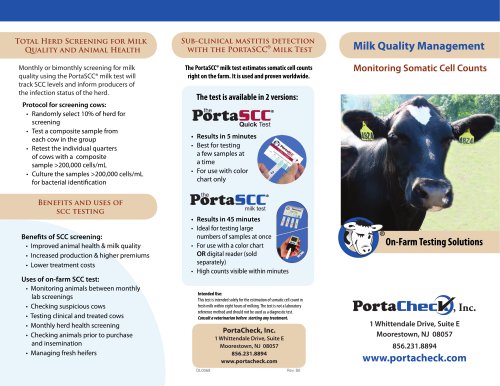
Catalog excerpts

What is Sub-clinical Ketosis? Ketosis in dairy cows occurs as a result of negative energy balance, a condition most common during the early postpartum period. During this time, milk production is increasing dramatically, while energy intake may not be adequate to sustain the higher production level. When this happens, cows metabolize body fat to meet their energy needs, resulting in increased production of ketones, a condition known as sub-clinical ketosis. (Duffield, 2001) The sub-clinical condition is much more common than clinical ketosis and has been associated with significant economic loss due to decreased milk production, impaired fertility, displaced abomasums and metritis. It is estimated that the incidence of sub-clinical ketosis during the first three weeks of lactation averages 40% - 60% in most herds. (Oetzel2013, University ofWI) Did you know? • Ketosis causes 506 lbs milk loss per affected cow. • Each case costs approximately $150. • Ketosis increases the risk of impaired fertility, and displaced abomasum. Source: Guard, Cornell University, 2008 Why Test for Sub-clinical Ketosis? • Monitoring for sub-clinical ketosis in individual cows provides means of early detection and treatment before clinical signs appear such as a foul odor on the cow's breath. • Monitoring at the herd level can help producers identify problems and make appropriate management decisions to correct nutritional and other ketosis related issues. • Healthier cows lead to better milk quality and increased production, which results in higher profits. BHB (beta-hydroxybutyrate) is one of the major ketone bodies formed during ketosis. How can you test for Sub-clinical Ketosis? Ketones can be monitored in blood, milk, or urine. • The gold standard for detecting sub-clinical ketosis measures BHBA in serum (lab test). • On-farm tests that use whole blood or milk samples have been developed offering immediate results at a lower cost. • Most ketosis powders and urine dipsticks change color in presence of other ketones , not BHB. Therefore, they are not as specific for sub-clinical ketosis as blood and milk tests. • Commonly used threshold values for on-farm testing of subclinical ketosis are: Blood BHB = 1200 pmol/L to 1400 pmol/L Milk BHB = 100 pmol/L to 200 pmol/L Items to consider • Mastitic cows and/or cows with high SCC (>1,000,000) may exhibit higher BHB levels. Suggested Protocols: Individual Cow Management Cows should be monitored for BHB at 2 to 14 days in milk when the incidence of sub-clinical ketosis peaks. In some cases, this period may extend to 21 days. For best results, do not check cows for BHB level within four (4) hours after feeding. Recommended protocol: • Test all fresh cows once a week during the first two weeks of lactation (identifies approximately 95% of sub-clinical cows). Alternate protocols: • Test all fresh cows once during the second week of lactation (identifies approximately 69% - 86% of sub-clinical cows). • Consider focusing on fresh older cows (second or greater lactation), fresh cows with body condition score > 4, or fresh cows during periods of heat stress. Protocol for problem herds: Herds experiencing an abnormal incidence of DA's, metritis, mastitis, weight loss, poor milk production, etc. • Test all fresh cows weekly for the first six weeks of lactati
Open the catalog to page 1
Suggested Protocols: Herd Level Management Milk & Blood Tests for Sub-clinical Ketosis For dry cow and transition periods: • Check 12 cows within the first two weeks of freshening. If two (2) or more cows are positive, consult with your veterinarian and/or nutritionist to evaluate herd management practices during the dry cow and transition periods. Monitoring Sub-clinical Ketosis in Dairy Cows • Simple, on-farm milk test to screen for BHB levels • Uses milk, not urine • Affordable and convenient 36 months room temperature stability For herd health and nutrition management: • Check 12 cows...
Open the catalog to page 2All PortaCheck catalogs and technical brochures
-
Portacheck RAINBOW
2 Pages
-
PortaSCC Flyer
2 Pages
-
Glucose Monitoring Brochure
2 Pages
-
PortaCheck Products Brochure
4 Pages
-
PortaSCC series
2 Pages
-
PortaSCC
2 Pages
-
UdderCheck
1 Pages
-
PortaBHB
1 Pages
-
BHBCheck
2 Pages











